9 /10 1 Votes9
Designer(s) Chris Wilson Artist(s) Erik Olofsson | 9/10 Steam Programmer(s) Jonathan Rogers Initial release date 23 October 2013 | |||||||||||||||||||||||||||||||||
Writer(s) Edwin McRaeBrian Weissman Composer(s) Adgio HutchingsKamil Orman-Janowski Modes Single-player video game, Multiplayer video game Similar | ||||||||||||||||||||||||||||||||||
Path of exile gameplay first look hd
Path of Exile is an online action role-playing game developed and published by Grinding Gear Games. It is a free-to-play title supported by microtransactions. An open beta was released on 23 January 2013, and the game was officially released on 23 October 2013.
Contents
- Path of exile gameplay first look hd
- Path of exile first impressions is it worth playing
- Gameplay
- Leagues
- Setting
- Development
- Expansions
- Business model
- Reception
- References
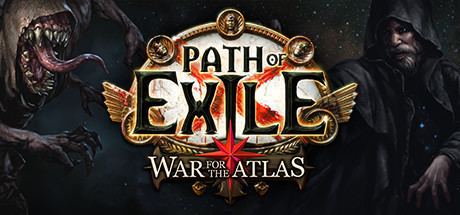
Path of exile first impressions is it worth playing
Gameplay
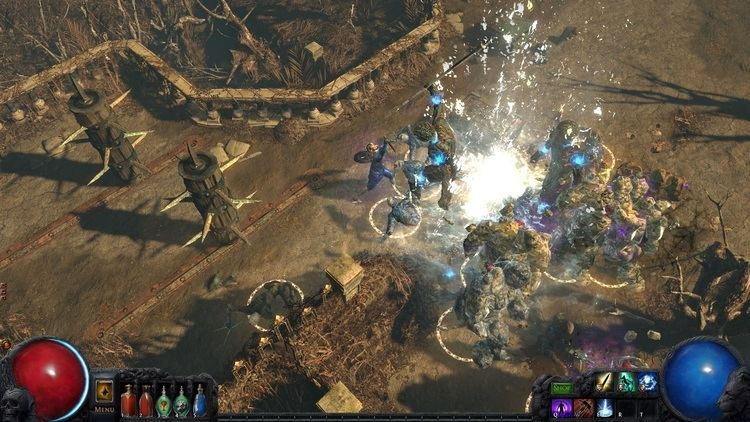
The player controls a single character from an overhead perspective and explores large outdoor areas and underground caves or dungeons, battling monsters and fulfilling quests from NPCs to gain experience points and equipment. The game borrows heavily from the Diablo series, particularly Diablo II. All areas aside from the central encampments are randomly generated for increased re-playability. While all players on a single server can freely mingle in encampments, gameplay outside of encampments is highly instanced, providing every player or party with an isolated map to freely explore.
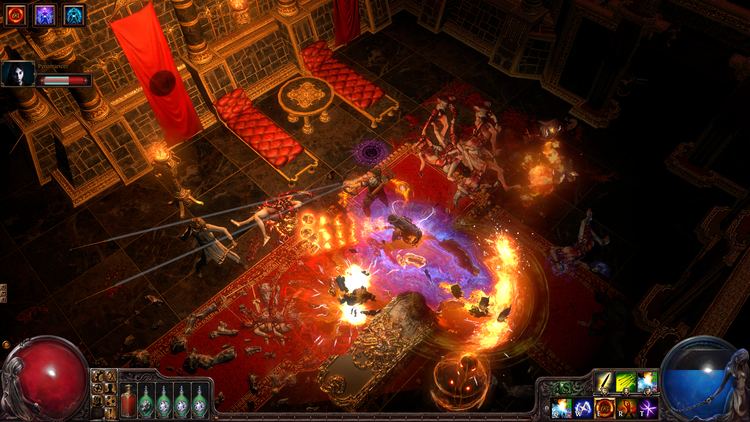
Players can initially choose from six available classes to play as (Duelist, Marauder, Ranger, Shadow, Templar, and Witch). Each of these classes are aligned with one or two of the three core attributes, Strength, Dexterity, or Intelligence. The final class, the Scion, can be unlocked by freeing her near the end of Act 3 on Normal difficulty, and is aligned with all three attributes. The different classes are not restricted from investing into skills not aligned with their core attributes, but will have easier access to skills that are aligned with their core attributes. Items are randomly generated from a wide variety of basic types and endowed with special properties and gem sockets. They come in different rarities with increasingly powerful properties. This makes a large part of gameplay dedicated to finding well-balanced and synergistic equipment. Skill gems can be placed in gem sockets of armor and weapons, giving them an active skill. As the character advances and levels up, the equipped skill gems also gain experience, allowing the skills themselves to be levelled up and increase in potency.
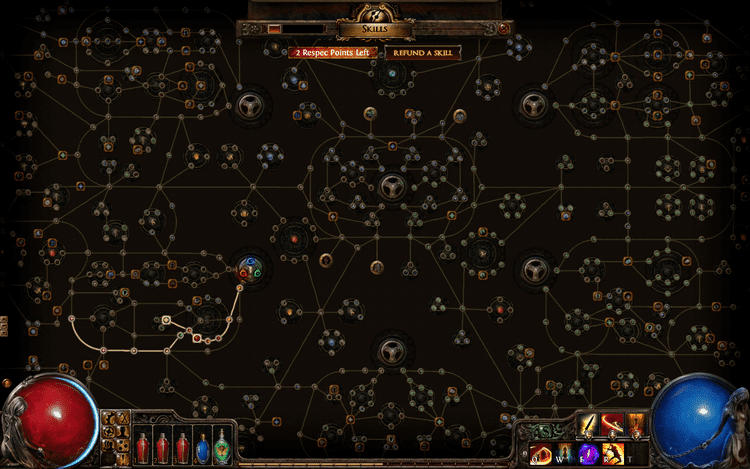
Active skills can be modified by items known as Support Gems. Depending upon the number of linked sockets the player possesses, a primary attack or skill can be modified with increased attack speed, faster projectiles, multiple projectiles, chaining hits, life leech, auto-cast spells on critical strike, and more. Given limits on the number of sockets, players must prioritize gem usage. All classes share the same selection of 1,325 passive skills, from which the player can choose one each time their character levels up, and as an occasional quest reward. These passive skills improve the core attributes and grant further enhancements such as increased Mana, Health, damage, defenses, regeneration, speed, and more. Each one of the characters start on a different position on the passive skill tree. The passive skill tree is arranged in a complex network starting in separate trunks for each class (aligned with the permutations of the three core attributes). The player must therefore not only focus on maximizing all modifiers related to his primary offense and defense, but must also take care to select the most efficient path through the passive skill tree. As of the 2.0 Awakening Release, the maximum possible number of passive skill points per character was 123 (99 from leveling and 24 from quest rewards.)
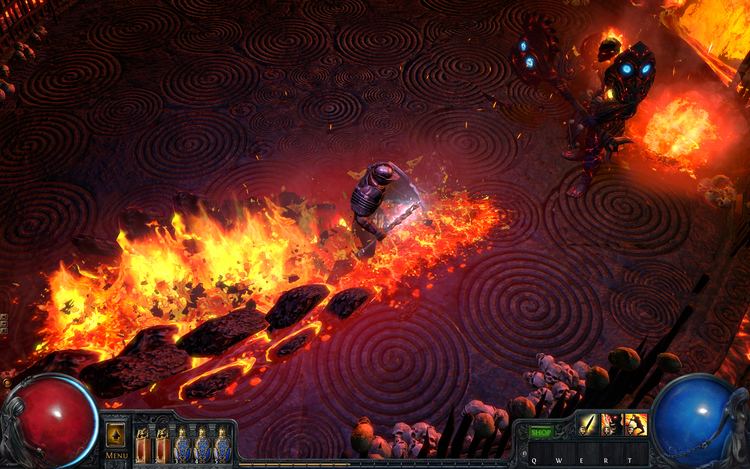
Path of Exile is unusual among action-RPG games in that there is no in-game currency. The game's economy is based on bartering "currency items." Unlike traditional game currencies, these items have their own inherent uses (such as upgrading an item's rarity level, rerolling affixes, or improving an item's quality) and thus provide their own money sinks to prevent inflation. Most of these items are used to modify and upgrade equipment, though some identify items, create portals to town or grant skill refund points.
Leagues
The game offers several alternate play modes Currently, the following permanent leagues are available:
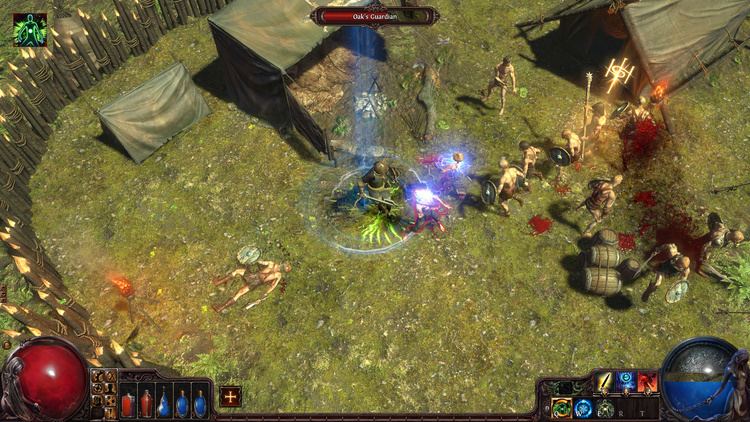
Current temporary (challenge) leagues:
Other leagues are usually designed for specific events. They have their own set of rules, item accessibility and aftermath. These rules widely vary depending on the league. For example, timed "Descent" league features another map set, new monster sets and rewards, but characters in this league are no longer available for playing after the league ends. "Turbo solo immolation" leagues, as another example, are running on the same maps as standard modes, but with much harder monsters, no partying, replacing physical damage with fire damage and monsters exploding on death—and return the survivors to Hardcore league (while dead characters resurrect in Standard). Racing leagues last between 30 minutes and 1 week. The permanent leagues have counterpart ladder leagues with different rulesets that last three months.
Setting
The game is set in a dark fantasy world. The player starts the game waking up on the shores of Wraeclast, a continent that once was the center of a mighty empire but is now a cursed land which serves as a penal colony for criminals and other unwanted individuals from the nearby island of Oriath. Regardless of the reasons for their exile, the player must now face the unforgiving wilderness and its dangerous inhabitants amidst the crumbling ruins and bloody secrets of the Eternal Empire and the Vaal civilization that came before, and band together with other exiles to survive.
Development
Path of Exile began when a small group of action role-playing game enthusiasts became frustrated by the lack of new releases in the genre and decided to develop their own game. It was developed under the radar for three years before being publicly announced on 1 September 2010. In the time since then Grinding Gear Games has published a number of development posts on their website ranging from screen shots of new classes, monsters and skills to presentations of game play or technical aspects.
Alpha started around June 2010, and ended when 0.9.0 was released in August 2011. Following a period under closed beta which players could pay to join, the developers started an open beta on 23 January 2013 which was free to play with purchasable microtransactions. The game was patched for release version 1.0.0 on 23 October 2013. On this date, it was also made available on Steam. The game continues to be updated with new content and fixes on a roughly monthly basis (from Version History).
Expansions
Path of Exile's first digital expansion, Sacrifice of the Vaal, was released on 5 March 2014. The expansion included new bosses, currency, areas, leagues, and PvP modes.
The second expansion, Forsaken Masters, was announced on 31 July 2014 and released on 20 August 2014 at 3pm Pacific. It comes with a host of new features, including crafting, recruitable NPCs called Masters (who remain at your hideout offering you daily training missions and specialized items), reworked passive skill tree, and customized personal hideouts.
The Awakening, the third and biggest expansion, entered closed beta on 20 April 2015. It includes the addition of a fourth Act containing new map tilesets, quests, and monsters. Other additions include new skills and items, passive skill tree sockets and jewels, item filters, two new challenge leagues, and game balance. The expansion also added an optional "Lockstep" mode in an effort to fix the "desync" network synchronization issues at the cost of latency. The Awakening expansion was released on July 10, 2015.
The Ascendancy expansion pack was released on March 4, 2016. Including more than the usual new items and skills, the expansion added several new skills and 19 new ascendancy classes. This expansion was also timed to be made live at the same time as the Perandus Challenge Leagues. The ascendancy classes are each tied to one of the base classes, with three ascendancy classes for each base class, except the Scion which only has one ascendancy class. Each of these new classes will contain its own unique ascendancy skill tree to advance. These new skill trees are much smaller than the base classes full-blown passive trees, but provide a unique specification to one's class not previously seen in the game. An example is the ascendant Necromancer skill tree, which would allow a witch's summoned minions to release chaos-damage explosions on death, increase the effect of auras, or increase spectres' health and damage.
An expansion, titled Atlas of Worlds, was released on September 2, 2016. It introduces a new end-game, 30 new maps, 19 new bosses, and an actual story.
The next expansion, titled Fall of Oriath adds a fifth act where the player returns home to Oriath in the midst of a slave rebellion against the Templars. The expansion also will replace cruel and merciless difficulties with Acts VI-X where the areas of the first five acts are revisited with changes to the environment that were the result of the players actions. The Pantheon system will also be added, where you can obtain interchangeable buffs from boss gods found in the new content.
Business model
The developers of Path of Exile stress that one of their core goals is to provide a genuinely free-to-play game financed only by "ethical micro-transactions". Most other games require either some initial or recurring payment or are financed by micro-transactions which are often hard to avoid because they provide significant game advantages. Path of Exile mainly offers cosmetic item skins for players willing to spend money on the game, but it does also gate specific account features such as semi-automated public trading inventories or additional character slots behind a paywall. There is also a plan for players to eventually be able to pay to create private, invite-only leagues, each secluded in its own economy. On 18 January 2017, Grinding Gear Games announced they would be expanding into the console market.
During closed beta, by 21 January 2013, Path of Exile received US$2.2m in crowd-sourced contributions.
Reception
Path of Exile was named 2013 PC Game of the Year by GameSpot and best PC role-playing game of 2013 by IGN.
By February 2014 the game had five million registered players.
